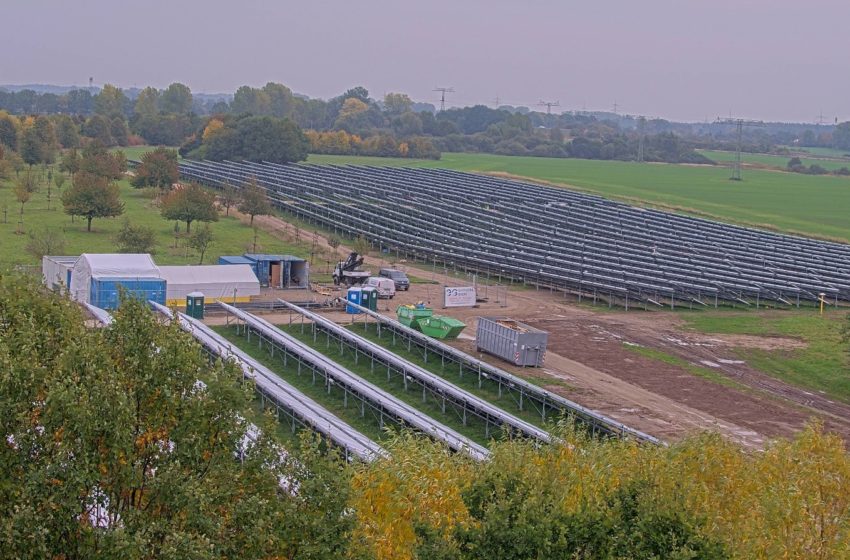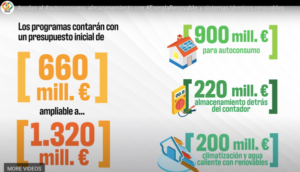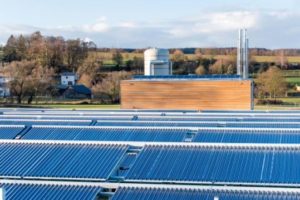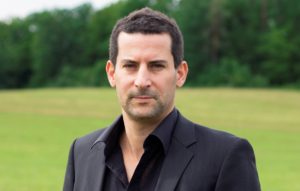Germany supports solar thermal in energy systems with cogeneration
October 28, 2021
The use of solar district heating is rapidly gaining momentum in Germany. One reason is that the first projects which have received state support under the Innovative Combined Heat and Power Programme are close to completion. An example of a local energy supplier that has profited from this is municipal utility in Greifswald, eastern Germany. There, the country’s largest solar heat plant so far, with 13 MWth, is currently under construction (see webcam photo of the site). The plant will go into operation in 2022 and provide heat for the district heating network in the town. The special aspect of the project is that the solar thermal plant is part of an overall concept, the so-called Innovative Combined Heat and Power or iCHP (innovativen Kraftwärmekopplung, iKWK). The German government has been supporting iCHP since 2018 with subsidies for the electricity produced through cogeneration.
Photo: Webcam Stadtwerke Greifswald
The German Cogeneration Act (Kraft-Wärme-Kopplungs-Gesetz, KWKG) defines iCHP as cogeneration systems that produce at least 35 % of the heat from sustainable energy sources. This can include solar thermal, heat pumps or geothermal plants. The iCHP installation also has to include a power-to-heat system. At times when a lot of electricity is available from wind power or photovoltaics, this electricity should be able to replace the heat production from the cogeneration plant to an extent of at least 30 %. So, when there is an oversupply of regenerative electricity in the public grid the cogeneration plant should not operate; instead the local utility should use electricity obtained directly from the grid.
In Greifswald, the iCHP system consists of a combined heat and power plant with a capacity of 4.5 MWel, a power-to-heat plant with 5 MWel and a large-scale solar collector field with a capacity of 13 MWth. In addition, there is a heat storage system with a storage capacity of 250 MWh. When the new iCHP system becomes operational, the share of heat provided to the district heating network by the conventional boiler will be reduced from 25 to 15 %. The sun will then contribute 3 % to the heating supply.
Support through a guaranteed electricity price
So how does the support scheme work? Germany invites tenders for a CHP capacity of 200 MW of electricity per year. 50 MW of this is reserved for iCHP. In two auctions per year, investors can bid for this total amount. Whereas for conventional CHP the maximum bid is 7 EUR-ct/kWhel, for iCHP it is 12 EUR-ct/kWhel. After the auction in June 2021 the average accepted bid was 11.57 EUR-ct/kWhel: close to the maximum. A further advantage of iCHP is that the support is paid for 45,000 hours of operation. For conventional CHP it is only 30,000 hours.
According to the German Federal Network Agency, of the around 50 iCHP projects with capacities of 1 to 10 MW power output that have had their bids accepted so far, 12 projects include solar thermal. Four of these consist of a combination of solar thermal and heat pumps. One project obtains heat from a deep geothermal system. All the others are based on large-scale heat pumps. The Federal Network Agency (Bundesnetzagentur) is the public authority in Germany that is responsible for the CHP tendering procedure.
Solar thermal disadvantaged
The scheme has been criticised in particular because support is only available above 1 MWel. Smaller local district heating projects are therefore excluded from support. Here, the industry is hoping for an improvement with the planned federal support for efficient heating networks (Bundesförderung effiziente Wärmenetze, BEW). This was originally planned for the year 2020 but a draft was only published in summer 2021. It is still unclear when this support will become available.
The solar thermal industry has a further criticism: if the requirement to cover 35 % of the heat demand from renewable energy is not fulfilled, the district heating operator has to pay high penalties. Whereas heat pumps and deep geothermal systems can easily guarantee a constant supply of heat, the solar thermal yield fluctuates from year to year depending on the solar irradiation. “In my opinion, the penalties in their current form are an obstacle”, said Christoph Bühler, Division Manager at Ritter XL, who is also constructing the plant at Greifswald. “Generally we consider it positive that suppliers and operators are committed to their guaranteed yield and must fulfil them. Nevertheless, I think a guarantee for irradiation conditions is more than questionable. I also object to the one-sidedness of this penalty as it only has to be paid for solar thermal projects”, continued Bühler. Local utility companies can reduce the risk of penalties by over-dimensioning the solar collector field. “This increases the investment, but it also usually reduces the heat price and increases the proportion of CO2-free heat in heating networks”, said Bühler. Nevertheless, even the threat of penalties could frighten off potential investors.
Bühler sees a further hurdle in the current iCHP scheme as being the time limit of 48 months between the bid being accepted in the auction and the plant going into operation – otherwise penalties occur. The bid from the utility in Greifswald was accepted in the first auction in June 2018. So time only remains until June 2023. “Often, authorisation procedures delay the progress of projects, so that realisation within the 48 months often becomes very hectic”, according to Bühler. “Here, an extension of the time allowed could be considered and the penalty for exceeding the time limit should be called into question. No local utility company exceeds the deadline voluntarily.”
Availability of land is often a major problem
The biggest problem for iCHP projects with solar thermal is often the availability of suitable land. “Of course, roof areas can also be used, but such large roofs are seldom available. And if they are, then their static strength is often insufficient”, explained Bühler. “In addition, one should realise that the specific investment cost of an installation on a roof is always higher than a system of the same size on the ground.” It is also an advantage for the economic viability of an iCHP system with solar thermal if existing infrastructure such as heat storage can be used. The modernisation of existing CHP plants is also allowed within the framework of iCHP projects.
Websites of organisations mentioned in this news article:


